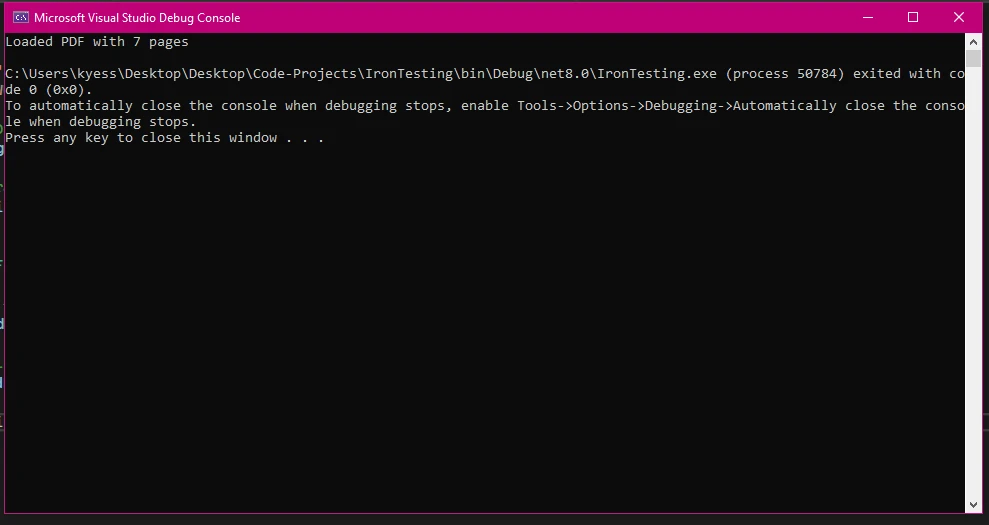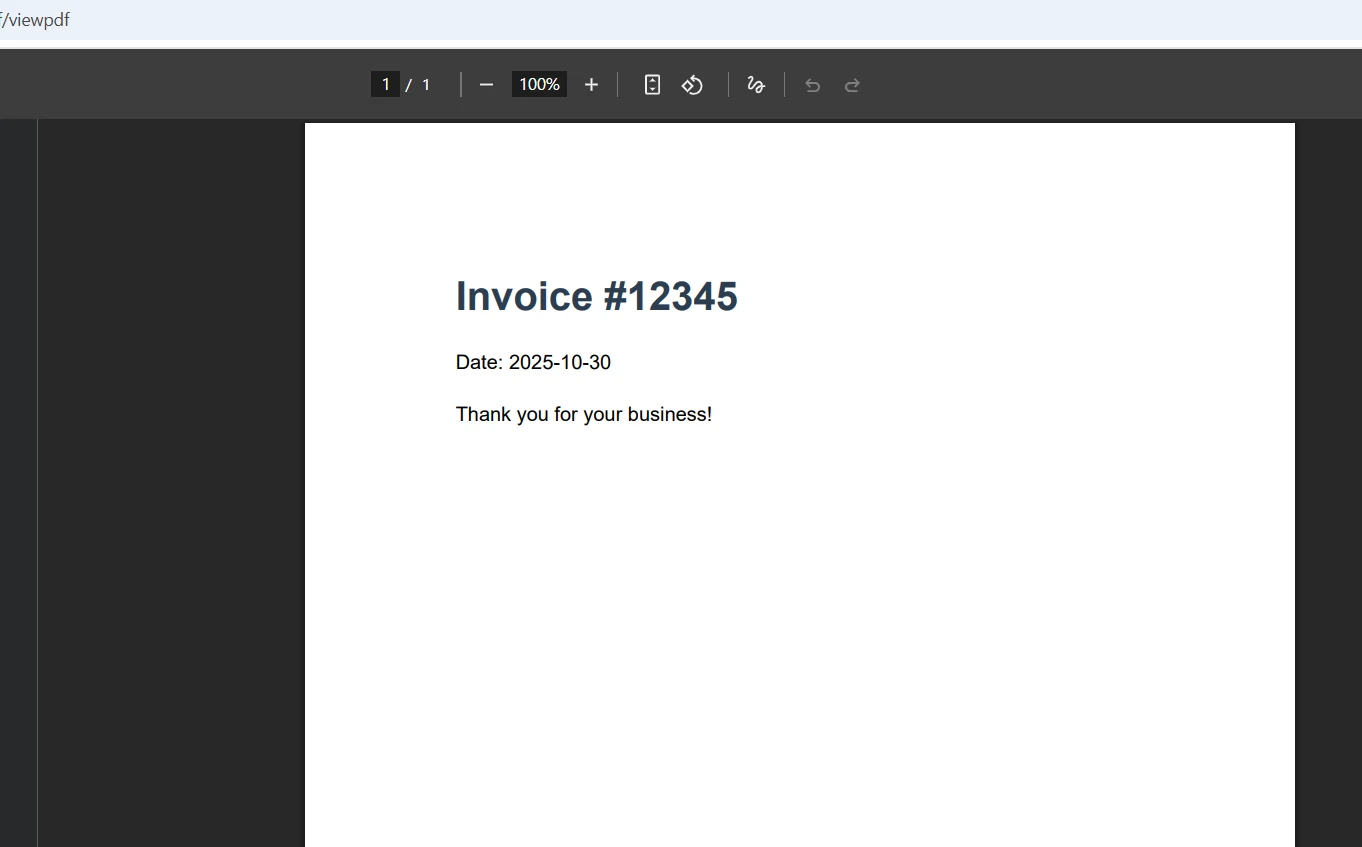How to Convert a PDF to a Byte Array in C#
Converting PDF type documents to byte arrays is a fundamental requirement in modern .NET applications. Whether you need to store PDFs in a database, transmit files through APIs, or handle document content in memory, understanding byte array conversion is essential. IronPDF simplifies this process with its intuitive API, allowing developers to convert files efficiently without complex code.
What Is a Byte Array and Why Convert PDF Files?
A byte array is a data structure that stores binary data as a sequence of bytes. When working with PDF documents, converting to byte arrays offers several advantages. This format enables efficient storage in database BLOB fields, seamless transmission through web services, and simplified file content manipulation in memory.
Developers frequently convert PDF files to byte arrays when building document management systems, implementing cloud storage solutions where users upload files, or creating APIs that handle PDF data. The binary data format ensures that document contents remain intact during transmission and storage, preserving all pages, formatting, and embedded resources. This process is similar to how you might handle other file types like PNG images or DOC files.
How to Convert PDF to Byte Array in C#?
IronPDF provides two straightforward methods to convert PDF documents to byte arrays. The BinaryData property offers direct access to the PDF's byte representation, while the Stream property returns a new MemoryStream for additional flexibility.
using IronPdf;
// Create a new PDF document from HTML
var renderer = new ChromePdfRenderer();
var pdf = renderer.RenderHtmlAsPdf("<h1>Sample Document</h1><p>This is test content.</p>");
// Method 1: Direct conversion to byte array
byte[] pdfBytes = pdf.BinaryData;
// Method 2: Using MemoryStream
using (var memoryStream = pdf.Stream)
{
byte[] pdfBytesFromStream = memoryStream.ToArray();
}
// Save byte array length for verification
System.Console.WriteLine($"PDF size: {pdfBytes.Length} bytes");using IronPdf;
// Create a new PDF document from HTML
var renderer = new ChromePdfRenderer();
var pdf = renderer.RenderHtmlAsPdf("<h1>Sample Document</h1><p>This is test content.</p>");
// Method 1: Direct conversion to byte array
byte[] pdfBytes = pdf.BinaryData;
// Method 2: Using MemoryStream
using (var memoryStream = pdf.Stream)
{
byte[] pdfBytesFromStream = memoryStream.ToArray();
}
// Save byte array length for verification
System.Console.WriteLine($"PDF size: {pdfBytes.Length} bytes");IRON VB CONVERTER ERROR developers@ironsoftware.comThe code above demonstrates both conversion methods. The BinaryData property provides the most direct approach, instantly returning the byte array representation. For scenarios requiring stream manipulation, the Stream property offers a MemoryStream instance that you can convert to bytes using the ToArray() method.
Console Output

How to Convert Existing PDF Documents to Byte Arrays?
When working with existing PDF documents on your computer, IronPDF makes it simple to read file content and convert it to byte arrays.
using IronPdf;
using System.IO;
// Load an existing PDF document
var existingPdf = PdfDocument.FromFile("report.pdf");
// Convert to byte array
byte[] fileBytes = existingPdf.BinaryData;
// Alternative: Using System.IO for direct file reading
byte[] directBytes = File.ReadAllBytes("report.pdf");
// Create PdfDocument from byte array
var loadedPdf = new PdfDocument(directBytes);
// Verify pages were loaded correctly
int pageCount = loadedPdf.PageCount;
System.Console.WriteLine($"Loaded PDF with {pageCount} pages");using IronPdf;
using System.IO;
// Load an existing PDF document
var existingPdf = PdfDocument.FromFile("report.pdf");
// Convert to byte array
byte[] fileBytes = existingPdf.BinaryData;
// Alternative: Using System.IO for direct file reading
byte[] directBytes = File.ReadAllBytes("report.pdf");
// Create PdfDocument from byte array
var loadedPdf = new PdfDocument(directBytes);
// Verify pages were loaded correctly
int pageCount = loadedPdf.PageCount;
System.Console.WriteLine($"Loaded PDF with {pageCount} pages");IRON VB CONVERTER ERROR developers@ironsoftware.comThe code above shows two approaches for handling existing files. IronPDF's FromFile method loads the document and provides access to the BinaryData property. Alternatively, you can read bytes directly using System.IO.File.ReadAllBytes() and then create a PdfDocument instance from those bytes.

How to Convert Byte Array Back to PDF?
Converting byte arrays back to PDF documents is equally straightforward. This function is essential when retrieving PDF data from databases or receiving files through APIs.
using IronPdf;
// Example byte array (typically from database or API)
byte[] pdfBytes = GetPdfBytesFromDatabase();
// Create PdfDocument from byte array
var pdfDocument = new PdfDocument(pdfBytes);
// Save the modified PDF
pdfDocument.SaveAs("modified-document.pdf");
// Or get updated bytes for storage
byte[] updatedBytes = pdfDocument.BinaryData;
// Mock method to simulate fetching PDF bytes from a database
byte[] GetPdfBytesFromDatabase()
{
// Simulate fetching PDF bytes
return File.ReadAllBytes("example.pdf");
}using IronPdf;
// Example byte array (typically from database or API)
byte[] pdfBytes = GetPdfBytesFromDatabase();
// Create PdfDocument from byte array
var pdfDocument = new PdfDocument(pdfBytes);
// Save the modified PDF
pdfDocument.SaveAs("modified-document.pdf");
// Or get updated bytes for storage
byte[] updatedBytes = pdfDocument.BinaryData;
// Mock method to simulate fetching PDF bytes from a database
byte[] GetPdfBytesFromDatabase()
{
// Simulate fetching PDF bytes
return File.ReadAllBytes("example.pdf");
}IRON VB CONVERTER ERROR developers@ironsoftware.comThe PdfDocument constructor accepts byte arrays directly, enabling seamless conversion from binary data back to a working PDF.

How to Work with Memory Streams and File Content?
Memory streams provide an efficient way to handle PDF content without creating temporary files. This approach is especially useful in web applications where you need to generate and serve PDFs dynamically.
using IronPdf;
using System.IO;
var renderer = new ChromePdfRenderer();
// Generate PDF in memory
using (var newMemoryStream = new MemoryStream())
{
// Create PDF and save to stream
var pdf = renderer.RenderHtmlAsPdf("<h1>Invoice</h1><p>Total: $100</p>");
pdf.SaveAs(newMemoryStream);
// Convert stream to byte array
byte[] pdfData = newMemoryStream.ToArray();
// Use bytes for web response, email attachment, or storage
SaveToDatabase(pdfData);
}
// Load PDF from byte array into new MemoryStream
byte[] storedBytes = GetFromDatabase();
using (var newMemoryStream = new MemoryStream(storedBytes))
{
var restoredPdf = new PdfDocument(newMemoryStream);
// Work with restored document
}using IronPdf;
using System.IO;
var renderer = new ChromePdfRenderer();
// Generate PDF in memory
using (var newMemoryStream = new MemoryStream())
{
// Create PDF and save to stream
var pdf = renderer.RenderHtmlAsPdf("<h1>Invoice</h1><p>Total: $100</p>");
pdf.SaveAs(newMemoryStream);
// Convert stream to byte array
byte[] pdfData = newMemoryStream.ToArray();
// Use bytes for web response, email attachment, or storage
SaveToDatabase(pdfData);
}
// Load PDF from byte array into new MemoryStream
byte[] storedBytes = GetFromDatabase();
using (var newMemoryStream = new MemoryStream(storedBytes))
{
var restoredPdf = new PdfDocument(newMemoryStream);
// Work with restored document
}IRON VB CONVERTER ERROR developers@ironsoftware.comThis example demonstrates the complete workflow of creating, saving, and loading PDFs using memory streams.
What Are Best Practices for Web Applications?
When serving PDFs in web applications, proper handling of byte arrays ensures optimal performance. Here's how to send PDF bytes to users in ASP.NET:
// In an MVC Controller
public FileResult DownloadPdf()
{
var renderer = new ChromePdfRenderer();
var pdf = renderer.RenderHtmlAsPdf("<h1>Report</h1>");
byte[] pdfBytes = pdf.BinaryData;
return File(pdfBytes, "application/pdf", "report.pdf");
}// In an MVC Controller
public FileResult DownloadPdf()
{
var renderer = new ChromePdfRenderer();
var pdf = renderer.RenderHtmlAsPdf("<h1>Report</h1>");
byte[] pdfBytes = pdf.BinaryData;
return File(pdfBytes, "application/pdf", "report.pdf");
}IRON VB CONVERTER ERROR developers@ironsoftware.comFor efficient storage and retrieval, consider these practices: dispose of PdfDocument objects when finished, use streaming for large files to avoid memory issues, and implement proper error handling for file operations.
Conclusion
IronPDF streamlines PDF to byte array C# conversion, providing developers with powerful yet simple methods to handle PDF documents as binary data. Whether you're building APIs, managing document databases, or creating web applications, IronPDF's BinaryData and Stream properties offer the flexibility needed for modern PDF processing. We hope this article has been helpful in understanding how to convert, save, and manipulate PDF files as byte arrays.

















